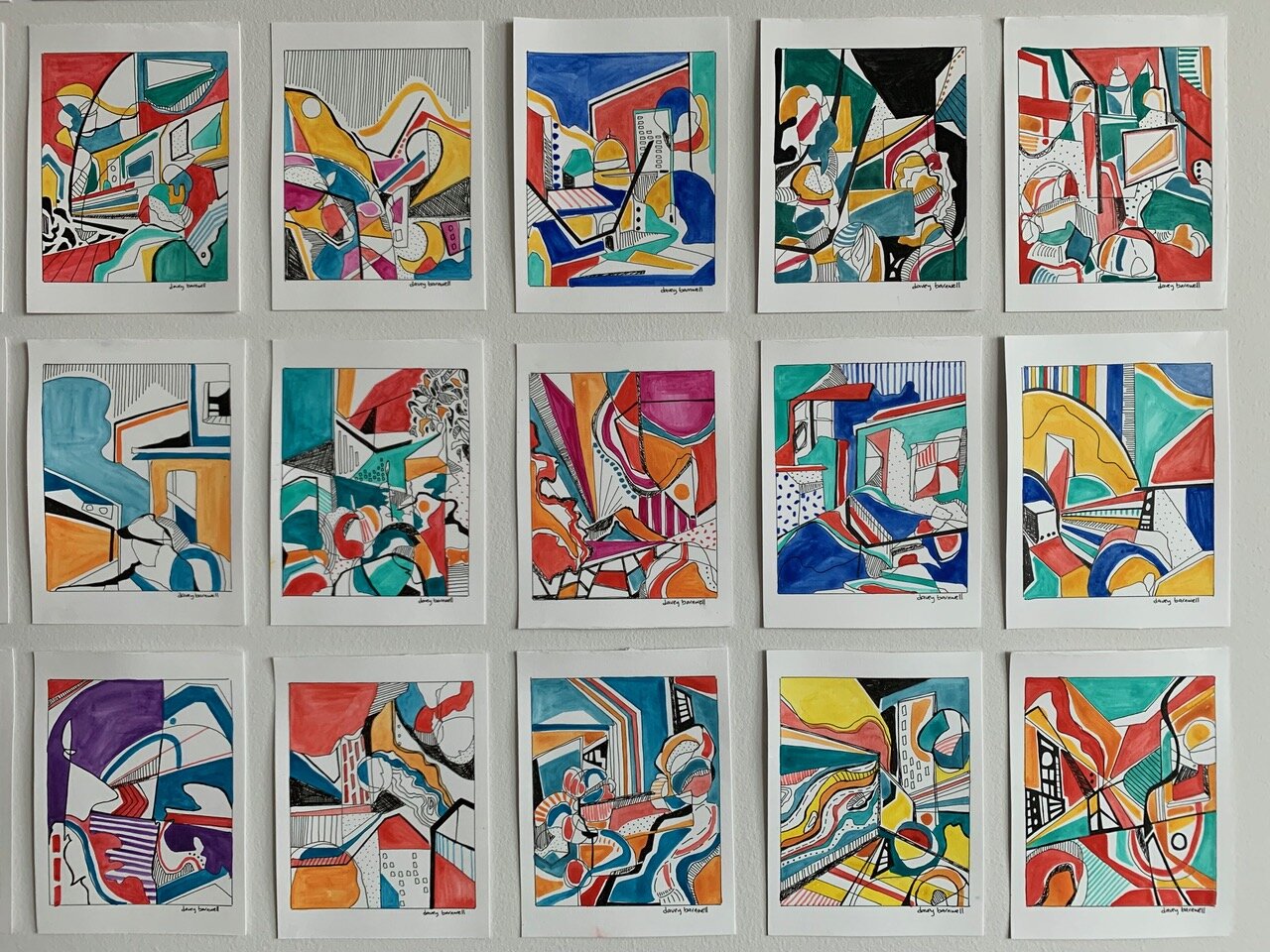Davey Barnwell: Color as Memory & Conversation
BY ASHLEY GIFFORD
It’s peculiar how so much has changed in only eight weeks, make that short time seem like a distant memory. At the end of February — a couple of weeks before Oregon’s Governor Kate Brown issued a stay at home order for the entire state due to COVID-19 — we had a studio visit with artist Davey Barnwell, after connecting over Instagram.
In an effort to take online connections offline and into the real world, and intrigued by a series where Barnwell impermanently installed her geometric and bold tonal paintings around old buildings in what appeared to be Southern Europe, it seemed like a great excuse to ask for a studio visit. Davey obliged and we met in her studio tucked inside a warehouse in NW Industrial Portland one weekday evening.
During our studio visit, we learned that Davey might be ‘new to Portland artist’, but she’s actually returning home. Her recent relocation back to Portland comes after working in New York City for a handful of years, and allows her the opportunity to be closer to family. Her practice includes painting, drawing and illustration. How and where it shows up is a crux of the artists’ practice; work can materialize traditionally with oil painting on canvas or on wood scraps, or bleed onto walls as a mural. As mentioned earlier, she’s also experimented with temporarily installing her work around old buildings during an artist residency in Greece and photographing it. And then there are the maps that Barnwell creates, which are more graphic design oriented but still rooted in her abstract work.
For us, visiting an artists’ studio always evokes a feeling of hope and possibility; in process work amongst finished pieces, materials and supplies at the ready, the stories that all the work has infused with it, where they have been and why and how they were made, sources of inspiration, all this and more is what makes these interactions with artists in their studio so very special. We hope that during these challenging times, that we're still able to connect, learn, and find inspiration from each other and our stories. It’s important now more than ever.
Ashley Gifford: Your work uses a lot of geometric forms and bright colors, could you talk about your color palette and how that's considered? What are some of the themes that you explore in your artwork?
Davey Barnwell: My choice of colors is somewhat intuitive, but often my work is grounded in the colors and patterns that I am seeing in real life—so I am often consciously referencing colors from specific images or moments. There are some colors that feel like touchstones in my work: red, teals, and oranges/yellows, as examples. When I was teaching in San Jose, red and blue became loaded with symbolism because of my students’ gang-related color associations and the significance of that language in their lives. After doing a residency in Greece, there is a certain tone of blue that now feels like a piece of home. Specific shades and patterns of orange are intrinsically linked to my experiences hiking and backpacking in the Southwestern states. All of this is to say that colors hold memories, and they become a visual language in my work.
AG: Could you talk about the visual language in your work and what you view are components of it? Or is there something a viewer has said about your work that also resonated with you?
DB: I’ve always seen my paintings a bit like conversations—the larger blocks of color are pauses, the smaller lines or shapes are words bouncing back and forth across a crowded room. When I obscure earlier layers in a work, I think of it as the inevitable process of developing the narrative of our memories. All of these elements have to be in balance to make a cohesive piece. My studio neighbor at a residency once said that he could tell my paintings were close to done when I started adding yellow—that has stuck with me because it is often true. I think certain colors tend to play certain roles in the conversations, though it’s not something I analyze consciously when I am in the middle of working.
AG: Are there artists that have influenced you and your work and if so, how exactly?
DB: There are many artists and writers that influence my work. Richard Diebenkorn and Stuart Davis are fundamental influences because of their approach to abstraction, referencing landscape or music through bold geometric compositions. I have also been inspired by mural artists including Alex Brewer, Ashley Mary, and Alexandra Bowman—there is something magical about how their work interacts with and elevates the built environment. I am drawn to artists and writers who are courageous in their marks or their words—writers include Terry Tempest Williams, Ann Patchett, and Tim Kreider. I have also been lucky enough to find many teachers, mentors, and collaborators who have inspired me to experiment and not take anything too seriously.
AG: When you see colors and patterns in real life that speak to you, how do you capture them to revisit later in the studio, if you do?
DB: I always carry my sketchbook and take a lot of photos!
AG: In your process and with experimenting, have you found either a subject manner or process that has stuck with you that you either revisit or continue to maintain?
DB: In terms of subject matter, most of my work is grounded in place, with references to cartography or physical locations. Sometimes figures find their way into the paintings, but I always go back to place. I do a lot of drawing and that has become central to my work. If I am stuck in a painting, I will start making smaller observational sketches of the painting in a different medium. I experimented with printmaking at the residency I did in Greece last summer, and that has stayed with me in an unexpected way—I have been gouging into the plywood of my paintings ever since. In school, I would carve into my paintings with the back of a hammer but I discovered that the printmaking tools are, unsurprisingly, a much easier way to edit and bring texture into the pieces.
AG: Could you tell us a little bit about yourself -- where are you from; where did you go to school, if you did, or any relevant experiences that can inform us about who you are?
DB: I’m originally from Portland, but only moved back a few years ago after jumping back and forth between coasts for a while. I went to school at Dartmouth College in New Hampshire, where I fell into studying Studio Art with a focus in painting. I was also doing a lot of writing and digital design. I took a geography class focused on the evolution and structure of cities and I think that influenced my painting practice. I also took a nature writing class and I know that influenced my painting practice. I have always tried to remain open to having disparate interests and not worrying too much about filling in all of the puzzle pieces. After graduating I thought I might want to teach, so I moved to San Jose, California and taught high school math and English for two years with Teach for America. On the side I continued painting in the corner of my apartment, and I started an after school art program for my students. After teaching, I moved to New York City in search of a more creative community—and I found that. I loved living in New York and my art practice was influenced daily by the architecture and energy of the city. A few years ago, I moved back to Portland to find more balance and fresh air, and it has been interesting to see how my work has evolved with more space to breathe. I have started doing murals as well as smaller works on paper.
AG: During our studio visit, you had drawings on your wall that you've created every Saturday of the month during the past several months, almost like a monthly visual journal entry, could you talk about this mini-practice; why did you decide to do it and what are some of the aspects of this consistent practice that you've realized while doing this?
DB: In December of last year, I participated in an Art for Advent call through Murze Magazine. The premise was to create a finished work each day of December. It helped provide a structured break from my usual practice and I enjoyed the excuse to sit down each day and do a full piece from start to finish (in contrast to my oil paintings which take weeks or months). I wanted to continue with a weekly version in 2020, so each Saturday morning I make a small 4” x 6” drawing/watercolor painting. It inevitably becomes a meditation on whatever I saw or experienced that week. I am finding it useful to have these pieces as weekly touchstones, and I am looking forward to seeing how the work evolves over the course of the weeks and months.
AG: What does a day in the studio look like for you? Are there any rituals or habits you have before you start or end your work in the studio?
DB: I work a full time job, so my time in the studio is often a bit splintered. I do best in small bursts at the studio, which is good because I sometimes only have a few hours at a time. Other than changing into my painting clothes, I don’t follow any strict ritual. Sometimes I feel like working on large oil paintings right away, but other times I am drawn to carving into the wood, doing smaller drawings, planning a mural project, or working on digital map designs. My studio time is my most unstructured time so I try to let it stay that way.
AG: What is something you'd like to do artistically that you haven't done before? Or is there a project you'd like to do that hasn't yet materialized or been possible?
DB: I would love to do more murals and especially some outdoor murals. When I was in Greece last summer I created large paintings on paper and hung them in the ruins around the village—that is what first got me seriously thinking about moving my work into murals, but I have only done indoor pieces so far. I enjoy the physicality of painting on such a large scale it would be fun to have the added challenge of being outside!
AG: Are there any other projects you recently completed that you'd like to share with us? Or any that you have coming up that you're able to share?
DB: I recently completed a series of pieces for a financial tech company downtown: one hand-painted mural, two vinyl wall graphics, and a custom oil painting. It was really rewarding to create work in multiple mediums for the same space and see how they interacted with the built environment. Looking ahead, I am starting some new series and I am participating in Portland Open Studios this fall.
Davey Barnwell is an artist currently based in Portland, Oregon. Her work is grounded in cartography, landscape, architecture, and the human interactions that happen in these physical spaces.
To see more of Davey’s work please visit her website or follow her on Instagram @daveybarnwell
Temporary installation of paintings during a residency in Greece.
The start of Davey Barnwe'll’s weekly archive from her Saturday morning exercise of making small drawing/watercolor paintings for 2020.
Mural in an office space




